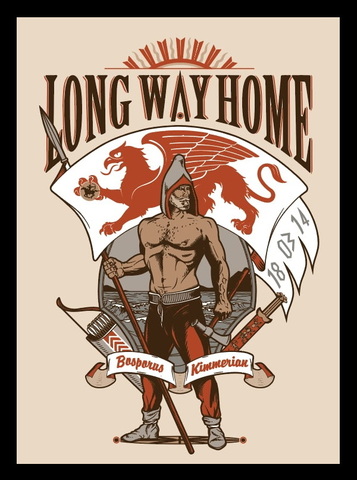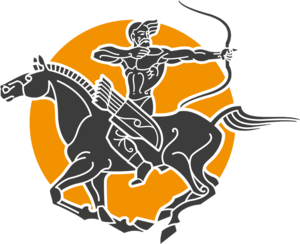Боспор Киммерийский
Боспор Киммерийский, позже названный Керченский проливом, позволяет контролировать вход в плодородную акваторию Азовского Моря – древнюю Меотиду, зимой по льду переходить из Тамани в Крым. Xотя он и не такой известный мост между цивилизациями - как его старший собрат Боспор Фракийский, именно здесь волны народов Великой Степи в лице киммерийцев и скифов наталкивались на города-государства эллинов, позже Византийской Империи. Вспенивали водную гладь весла греческих триер, груженые тяжелой причерноморской пшеницей, а прерывание этого маршрута могло вызвать голод в Афинах. Интересно, что этот экспортный маршрут работает и сейчас и даже бьет рекорды времен СССР.
Удивительным эпизодом является завоевание Крыма древнегерманскими готами в середине третьего века нашей эры, часть которых продолжила разорять ромеев в Малой Азии и Фракии, а часть осталась и очень долго сохраняла собственную идентичность. В конце 8 века Иоанн Готский изгнал хазар из Крыма, в 10 веке они вернулись, после чего готы заключили союз с Святославом, который полностью уничтожил Хазарский каганат. Занимательно, что христианские лидеры готов обратились к последнему русскому князю, cохраняющему исконное мировоззрение и не принявшему иноземную религию. В пределах княжества Феодоро, даже будучи окружены мусульманским населением, еще в семнадцатом веке, готы продолжали использовать алфавит 4 века н.э. составленный епископом Вульфилой! Позже Великую Степь представляли уже хазары и половцы, а оседлую цивилизацию русские города Тмутараканского княжества.
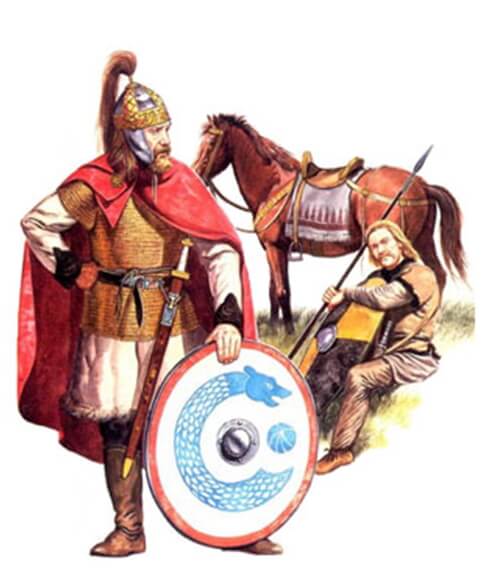
Иллюстрация 1. Крымские готы
Со временем в регион заходят итальянские талассократии. В 1206 Венеция вместе с половцами закрепляется в Солдайе (Судаке). Двумя годами ранее, в рамках борьбы за господство в восточном средиземноморье, Венеция высадила у Константинополя банду крестоносцев, что привело к его разграблению и захвату. Таким образом, контроль над Боспором Киммерийским определялся контролем над Боспором Фракийским и Дарданеллами. В 1261 Генузская республика в союзе с Никейской империей выбивают венецианских ставленников из Константинополя. И вот течение двух веков на обоих берегах «Капитанства Готия», как они его называли, доминируют генуэзцы.
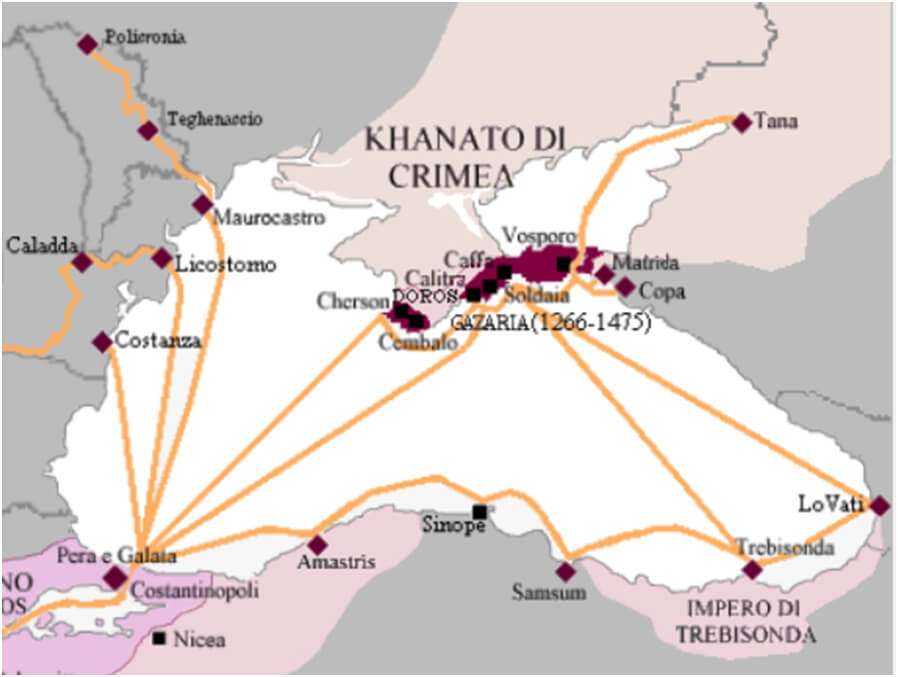
Иллюстрация 2. Опорные пункты и маршруты Генуэзской республики в Черном море в 13-15 веке
Их каравеллы курсируют от Фландрии до Марокко, от Триполи и Египта до крымских берегов. После, с конца пятнадцатого века, эти территории переходят к Османской империи, а с 1782 присоединяются к Российской. В 1790 году турки пытались высадить десант, но лишь щедро засыпали дно ядрами после четырехчасовой битвы с эскадрой Ушакова. В 1885 году появились англо-французcкие захватчики, характерно, что в ходе войны, например, Керчь, была полностью разграблена, доменная печь взорвана, а оборудование сталеплавильного завода было погружено на судно и вывезено в Англию. Тот же подход англичане применяли и в Индии, где уничтожение обрабатывающей промышленности и запрет на торговлю в итоге привели к гибели более 30 миллионов человек. В 1899 выходит «Проект поднятия уровня Азовского моря запрудою Керченского пролива» - первое предложение по постройке моста через Боспор Киммерийский от Владимира Менделеева — сына создателя периодической таблицы химических элементов. В 1918 Крым занял кайзеровский Рейх, но через полгода передал его Антанте и белогвардейцам. Боспор же рисковал быть заперт англичанами, которые вместе с другими членами Антанты решили прекратить существование Турции как геополитически сильного государства, ограничив ее территорию областью вокруг Анкары с выходом к Черному морю. Для недопущения этого Советская Россия предоставила в дар Турции более 80 миллионов турецких лир золотом, что превышало годовой бюджет правительства Мустафы Кемаля в 1920-х годах. Были поставлены более половины использованных в военных действиях патронов, четверть винтовок и орудий, треть орудийных снарядов и даже 1500 сабель! Таким образом, Россия опосредовано выгнала англичан с проливов и обеспечила выход Черноморского флота в Средиземное море в 20 веке, что сохраняется и поныне.

Иллюстрация 3. Современный герб республики Крым
Во время ВОВ наследники древних германцев пытались воссоздать в Крыму колонию немцев из южного Тироля, построить автомагистраль из Гамбурга, которая позволила бы доезжать до «всенемецкой здравницы» (со слов фюрера) за два часа. Сам Крым предполагалось переименовать в Gotenland (земля готов), Cимферополь в Gotenburg (город готов), Севастополь в Theoderichshafen (Гавань Теодориха, вождя остготов, который по приказу базилевса завоевал весь Апеннинский полуостров в конце 5 века нашей эры, потомок волн готов, прошедших причерноморскими степями двумя веками ранее). В 1943 Гитлер приказал начать постройку пятикилометрового автомобильного и железнодорожного моста через Боспор Киммерийский для поддержки вторжения в Иран через Кавказ, при отступлении германских войск канатная дорога была частично уничтожена, но в 1944 была восстановлена советскими военными инженерами. В этом же году был построен железнодорожный мост, к сожалению, из-за начавшихся декабрьских штормов получилось установить только часть ледорезов, поэтому в 1945 мост разрушился.
Сейчас по открытому в 2018 году самому длинному в России Крымскому мосту несутся автомобили и поезда, шум шин растворяется в звуке мерно перекатывающихся волн, а под водной гладью лежат остатки тысяч лет напряженной борьбы. Только при установке свай со дна был поднят штурмовик Ил-2 и торпедный катер.
Отдельно хотелось бы остановиться на характерном для киммерийцев и скифов головном уборе, который надет на нашем воине-киммерийце. Позже он будет назван фригийским колпаком, и хотя сами фригийцы, по сообщению Геродота, пришли с Балкан, сходство щитов и шлемов позволяет предположить некое родство с мигрировавшими в 8 веке до н.э. в Малую Азию киммерийцами.
Потом этот колпак начали носить освобожденные рабы в Древнем Риме как атрибут Либертас — богини свободы, собственно которой и воздвигнута знаменитая статуя в Нью-Йорке. Бог Митра, рождающийся из скалы-материи, иссекающий первородного быка (животное начало?) на сотнях скульптур по всему древнему миру и в итоге пирующий с солнцем, изображался только в этом колпаке. Марианна, символ французской революции с обнаженной грудью, тоже носила его в красном цвете с кокардой. В 1792 захваченный в Тюильри Людовик XVI был вынужден надеть красный колпак, поданный ему на пике, что, впрочем, не спасло его от гильотины.

Иллюстрация 4. Девушки в образе Марианны во фригийском колпаке

Иллюстрация 5. Древний бог Митра, поражающий быка во фригийском колпаке
Печать Сената США, гербы Аргентины, Боливии, Кубы, Колумбии, Сальвадора, Гаити, Никарагуа и Парагвая – везде изображен красный колпак свободы. Такие интересные метаморфозы возникли на пути на первый взгляд простой войлочной шапки кочевников, по смыслу подобной той, что сейчас продолжают носить киргизы и другие кочевые народы.
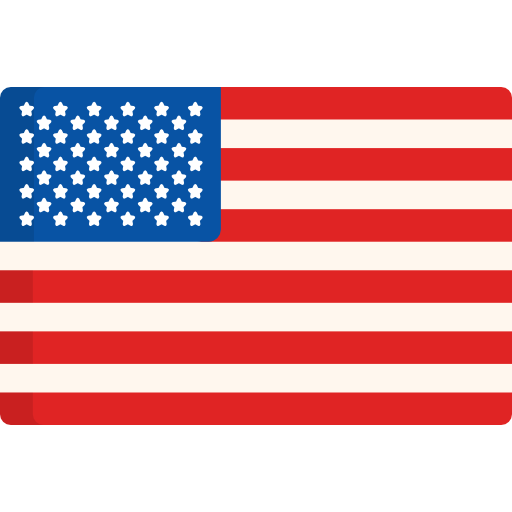 En
En Ru
Ru

